 |
The Scottish Military Research Group - Commemorations Project
(Registered Scottish Charity No. SC043826). Please visit our homepage at www.scottishmilitaryresearch.co.uk
|
| View previous topic :: View next topic |
| Author |
Message |
Adam Brown
Curator

Joined: 14 Dec 2006
Posts: 7312
Location: Edinburgh (From Sutherland)
|
 Posted: Mon Dec 17, 2007 3:40 pm Post subject: Dunbar, East Lothian Posted: Mon Dec 17, 2007 3:40 pm Post subject: Dunbar, East Lothian |
 |
|
There are no photographs of this memorial available yet but we have two sources confirming its location. One of the sources is the Royal Commission for Ancient and Historic Monuments in Scotland (RCAHMS) and the details are taken from their Canmore database. The other source is the United Kingdom National Inventory of War Memorials (UKNIWM) database
From RCAHMS
http://www.rcahms.gov.uk/pls/portal/newcanmore.newcandig_details_gis?inumlink=215608 (Link will only work if you have registered with Canmore)
Dunbar, Queen's Road, Parish War Memorial
Type of Site: War Memorial
NMRS Number: NT67NE 301
Map reference: NT 6817 7863
Parish: Dunbar
Council: East Lothian
Former District: East Lothian
Former Region: Lothian
From UKNIWM
UKNIWM Ref no: 5649
http://www.ukniwm.org.uk/server/show/conMemorial.5649/fromUkniwmSearch/1
DUNBAR, BURGH AND PARISH
Address
BAYSWELL HOTEL
MARINE DRIVE
DUNBAR
LOTHIAN
SCOTLAND
Type: CROSS
Other Location Details: ON CLIFF TOP
OS Map Ref: NT 673 794
Previous Locations
Address Date Moved Reason for Move
BAYSWELL HOTAL
MARINE DRIVE
DUNBAR
LOTHIAN
SCOTLAND
1989 MOVED SOME 200 YARDS NEARER TO HOTEL DUE TO RISK FROM CLIFF EROSION.
Inscription
IN MEMORY
OF THOSE FROM THE
BURGH AND PARISH
OF DUNBAR
WHO
GAVE THEIR LIVES
IN THE GREAT WAR
1914-1918
"THEIR NAME LIVETH FOR EVERMORE"
(NAMES)
Components
Component Material(s)
CROSS STONE 16FT
Physical Description
CELTIC
METAL CRUCIFIX IN CENTRE
Wars Commemorated & People Remembered
FIRST WORLD WAR
Died 136
SECOND WORLD WAR
Died 66
Last edited by Adam Brown on Sun Jun 15, 2008 9:42 pm; edited 1 time in total |
|
| Back to top |
|
 |
David McNay
Administrator

Joined: 14 Dec 2006
Posts: 11425
Location: Lanarkshire, Scotland
|
 Posted: Mon Dec 17, 2007 10:29 pm Post subject: Posted: Mon Dec 17, 2007 10:29 pm Post subject: |
 |
|
Seems to be a difference of address there. Queens Road and Marine Drive.
They may be adjacent, I don't know the area. |
|
| Back to top |
|
 |
Adam Brown
Curator

Joined: 14 Dec 2006
Posts: 7312
Location: Edinburgh (From Sutherland)
|
 Posted: Sun Jun 15, 2008 9:47 pm Post subject: Posted: Sun Jun 15, 2008 9:47 pm Post subject: |
 |
|
David, both addresses are wrong. It is Marine Road.
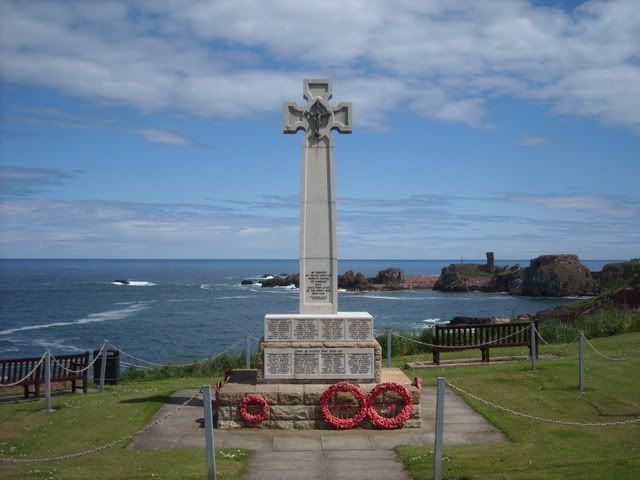

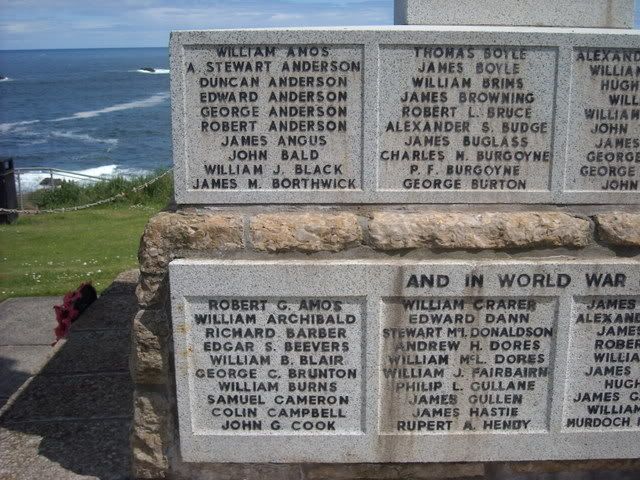
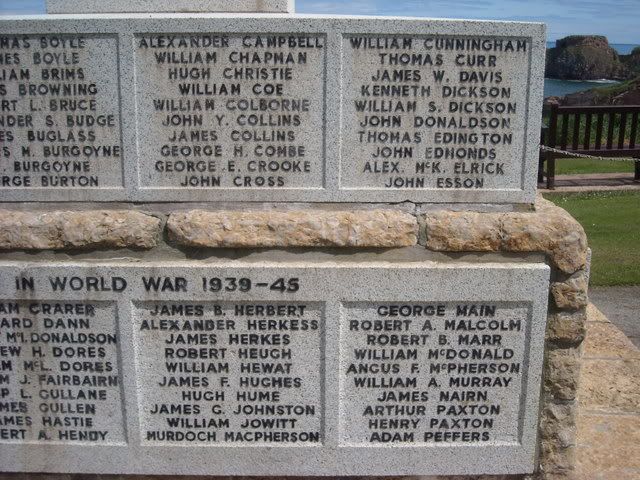
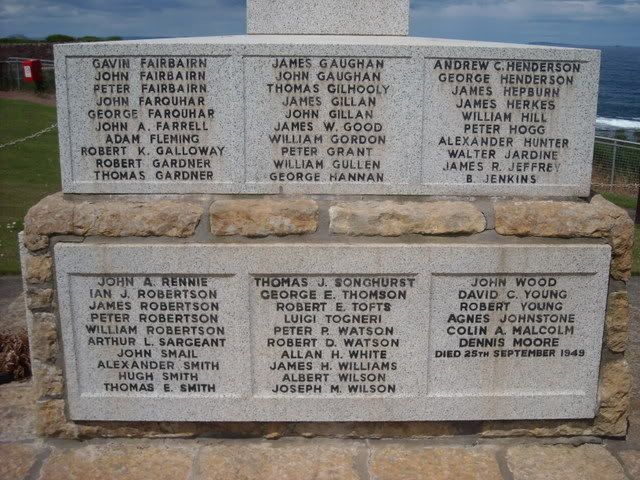
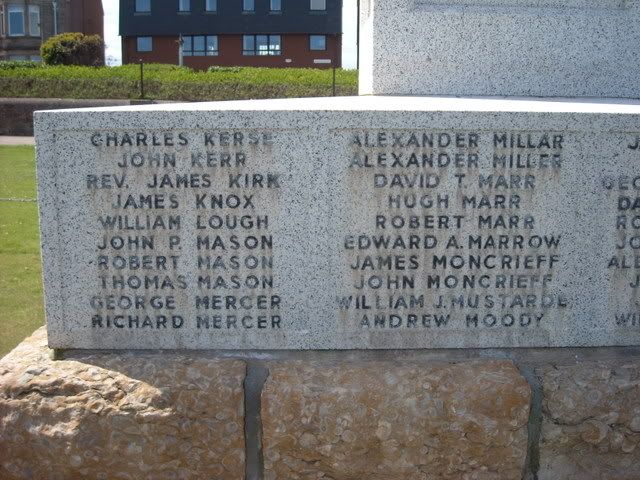
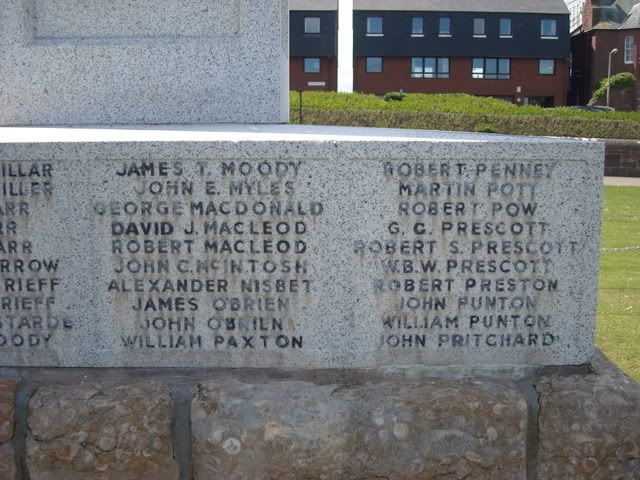
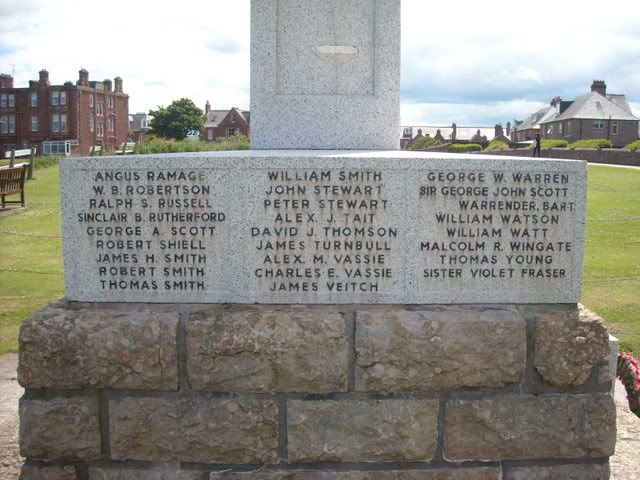
|
|
| Back to top |
|
 |
Adam Brown
Curator

Joined: 14 Dec 2006
Posts: 7312
Location: Edinburgh (From Sutherland)
|
 Posted: Sun Jun 15, 2008 10:31 pm Post subject: Posted: Sun Jun 15, 2008 10:31 pm Post subject: |
 |
|
I had to look up some of these names
KIRK, The Rev. JAMES
Nationality: United Kingdom
Rank: Chaplain 4th Class
Regiment/Service: Army Chaplains' Department
Secondary Regiment: Seaforth Highlanders
Secondary Unit Text: attd. 2nd Bn.
Age: 44
Date of Death: 01/04/1918
Awards: M C
Additional information: Son of James and Janet Kirk, of Kirkford, nr. Cowdenbeath, Fife; husband of Eliz. M. Kirk, of 8, Woodhall Terrace, Juniper Green, Midlothian. MA
Casualty Type: Commonwealth War Dead
Grave/Memorial Reference: IV. E. 2.
Cemetery: WIMEREUX COMMUNAL CEMETERY
He was minister in Dunbar before the war and from 1903-1910 Minister of Forteviot parish in Perthshire. He is also commemorated in the church in Forteviot. See here
Sir George John Scott Warrander Bart is not listed in the CWGC database but it looks like he was this very distinguished chap...
From http://www.thepeerage.com/p14067.htm#i140666
Vice-Admiral Sir George John Scott Warrender of Lochend, 7th Bt.
Commissioned, in the service of the Royal Navy. He fought in the Zulu War in 1879. He gained the rank of Captain. He was invested as a Knight Commander, Order of the Bath (K.C.B.). He held the office of Justice of the Peace (J.P.) for Edinburgh. He was invested as a Knight Commander, Royal Victorian Order (K.C.V.O.). He fought in the Boxer Rebellion in 1900. He succeeded to the title of 7th Baronet Warrender, of Lochend, co. Haddington [G.B., 1715] on 13 June 1901. He was invested as a Companion, Order of the Bath (C.B.) in 1902. He was Aide-de-Camp to HM King Edward VII between 1907 and 1908. He was Commander-in-Chief of the East Indies Station between 1907 and 1909. He was commander of the 2nd Cruiser Squadron between 1910 and 1912.
He was Commander-in-Chief of the Devonport in 1916.
Born on 31 July 1860. He was the son of Sir George Warrender of Lochend, 6th Bt. and Helen Purves-Hume-Campbell. He married Lady Ethel Maud Ashley-Cooper, daughter of Anthony Ashley-Cooper, 8th Earl of Shaftesbury and Lady Harriet Augusta Anna Seymourina Chichester, on 6 February 1894 at St. Paul's Church, Knightsbridge, London, England
He died on 8 January 1917 at age 56.
I also tried looking up Sister Violet Fraser but couldn't find her.
Adam
Last edited by Adam Brown on Sat Jun 28, 2008 9:17 am; edited 1 time in total |
|
| Back to top |
|
 |
Adam Brown
Curator

Joined: 14 Dec 2006
Posts: 7312
Location: Edinburgh (From Sutherland)
|
 Posted: Sun Jun 15, 2008 10:37 pm Post subject: Posted: Sun Jun 15, 2008 10:37 pm Post subject: |
 |
|
Dennis Moore, the last man listed died in Malaya in 1949 whilst serving with the Scots Guards
MOORE, Dennis
Rank: Guardsman
Number: 22022534
Regiment/Corps: SCOTS GUARDS
Place of Birth/Home Town: Dunbar, East Lothian
Date of Birth: 28 September 1929
Age: 19
Date of Death: 25 September 1949
Cemetery Name: Cheras Road Christian Cemetery
Cemetery Address: Kuala Lumpu, Malaya
Grave: Mil Sec: 29: 956
Included on Armed Forces Memorial: Yes
Included on Roll of Honour:Yes
MALCOLM, COLIN ALISTAIR
Nationality: United Kingdom
Rank: Sergeant
Regiment/Service: Royal Air Force
Unit Text: 42 Sqdn.
Age: 26
Date of Death: 21/06/1940
Service No: 523441
Additional information: Son of Alexander and Mildred M. Malcolm, of Dunbar, East Lothian.
Casualty Type: Commonwealth War Dead
Grave/Memorial Reference: Panel 17.
Memorial: RUNNYMEDE MEMORIAL
JOHNSTONE, AGNES C
Nationality: United Kingdom
Rank: Private
Regiment/Service: Auxiliary Territorial Service
Age: 25
Date of Death: 15/01/1942
Service No: W/171656
Additional information: Daughter of John and Margaret Johnstone, of Dunbar.
Casualty Type: Commonwealth War Dead
Grave/Memorial Reference: Sec. A. Grave 33.
Cemetery: DUNBAR CEMETERY
TOGNERI, LUIGI FRANCISCO
Nationality: United Kingdom
Rank: Surgeon
Regiment/Service: Merchant Navy
Unit Text: S.S. Empire Heritage (Cardiff)
Age: 30
Date of Death: 08/09/1944
Awards: M B E
Additional information: Son of Joseph and Angene Togneri; husband of Hellen B. Togneri, of Edinburgh. M.B., Ch.B.
Casualty Type: Commonwealth War Dead
Grave/Memorial Reference: Panel 42.
Memorial: TOWER HILL MEMORIAL |
|
| Back to top |
|
 |
DelBoy

Joined: 12 Jul 2007
Posts: 4858
Location: The County of Angus
|
 Posted: Tue Sep 27, 2011 4:03 am Post subject: Memorial Transcription Posted: Tue Sep 27, 2011 4:03 am Post subject: Memorial Transcription |
 |
|
WW1
William Amos
A. Stewart Anderson
Duncan Anderson
Edward Anderson
George Anderson
Robert Anderson
James Angus
John Bald
William J. Black
James M. Borthwick
Thomas Boyce
James Boyle
William Brims
James Browning
Robert L. Bruce
Alexander S. Budge
James Buglass
Charles H. Burgoyne
P.F. Burgoyne
George Burton
Alexander Campbell
William Chapman
Hugh Christie
William Coe
William Colborne
John Y. Collins
James Collins
George H. Combe
George E. Crooke
John Cross
William Cunningham
Thomas Curr
James W. Davis
Kenneth Dickson
William S. Dickson
John Donaldson
Thomas Edington
John Edmonds
Alex. McK. Elrick
John Esson
Gavin Fairbairn
John Fairbairn
Peter Fairbairn
John Farquhar
John A. Farrell
Adam Fleming
Robert K. Galloway
Robert Gardner
Thomas Gardner
James Gaughan
John Gaughan
Thomas Gilhooly
James Gillan
John Gillan
James W. Good
William Gordon
Peter Grant
William Gullen
George Hannah
Andrew C. Henderson
George Henderson
James Hepburn
James Herkes
William Hill
Peter Hogg
Alexander Hunter
Walter Jardine
James R. Jeffrey
B. Jenkins
Charles Kerse
John Kerr
Rev. James Kirk
James Knox
William Lough
John P. Mason
Robert Maon
Thomas Mason
George Mercer
Richard Mercer
Alexander Millar
Alexander Miller
David T. Marr
Hugh Marr
Robert Marr
Edward A. Marrow
James Moncrieff
John Moncrieff
William J. Mustarde
Andrew Moody
James T. Moody
John E. Myles
George MacDonald
David J. MacLeod
Robert MacLeod
John C. McIntosh
Alexander Nisbet
James O'Brien
John O'Brien
William Paxton
Robert Penney
Martin Pott
Robert Pow
G.C. Prescott
Robert S. Prescott
W.B.W. Prescott
Robert Preston
John Punton
William Punton
John Pritchard
Angus Ramage
W.B. Robertson
Ralph S. Russell
Sinclair B. Rutherford
George A. Scott
Robert Shiell
James H. Smith
Robert Smith
Thomas Smith
William Smith
John Stewart
Peter Stewart
Peter Stewart
Alex. J. Tait
David J. Thomson
James Turnbull
Alex. M. Vassie
Charles E. Vassie
James Veitch
George W. Warren
Sir George John Scott Warrender, Bart.
William Watson
William Watt
Malcolm R. Wingate
Thomas Young
Sister Violet Fraser
WW2
Robert G. Amos
William Archibald
Richard Barber
Edgar S. Beevers
William B. Blair
George C. Brunton
William Burns
Samuel Cameron
Colin Campbell
John G. Cook
William Crarer
Edward Dann
Stewart McL. Donaldson
Andrew H. Dores
William McL. Dores
William J. Fairbairn
Philip L. Gullane
James Gullen
James Hastie
Rupert A. Hendy
James B. Herbert
Alexander Herkess
James Herkes
Robert Heugh
William Hewat
James F. Hughes
Hugh Hume
James G. Johnston
William Jowitt
Murdoch MacPherson
George Main
Robert Main
Robert A. Malcolm
Robert B. Marr
William McDonald
Angus F. McPherson
William A. Murray
James Nairn
Arthur Paxton
Henry Paxton
Adam Peffers
John A. Rennie
Ian J. Robertson
James Robertson
Peter Robertson
William Robertson
Arthur L. Sargeant
John Smail
Alexander Smith
Hugh Smith
Thomas E. Smith
Thomas J. Songhurst
George E. Thomson
Robert E. Tofts
Luigi Togneri
Peter P. Watson
Robert Watson
Allan H. White
James H. Williams
Albert Wilson
Joseph M. Wilson
John Wood
David C. Young
Robert Young
Agnes Johnstone
Colin A. Malcolm
Dennis Moore - Died 25th September 1949 |
|
| Back to top |
|
 |
Tonym

Joined: 18 Jan 2007
Posts: 224
Location: East Sussex
|
 Posted: Tue Sep 27, 2011 10:21 am Post subject: Posted: Tue Sep 27, 2011 10:21 am Post subject: |
 |
|
There appears to be no Sister Violet Fraser on CWGC but SNWM=
Surname FRASER
Firstname Violet M
Service Number
Date Death 05/03/1919
Decoration
Place of birth
Other
SNWM roll WOMEN'S SERVICES.
Rank Unknown
Theatre of death
Was she still serving when she died?
Tony
_________________
Pte. W. BROWN, Middlesex Regiment, K.I.A Battle of The Somme.
Sgt. J. V. MURPHY, The Queen's Own Cameron Highlanders, D.O.W Monte Cassino, Italy. |
|
| Back to top |
|
 |
DelBoy

Joined: 12 Jul 2007
Posts: 4858
Location: The County of Angus
|
 Posted: Tue Sep 27, 2011 2:14 pm Post subject: Sir George John Scott Warrender Posted: Tue Sep 27, 2011 2:14 pm Post subject: Sir George John Scott Warrender |
 |
|
I had the same problem Tony, I saw the SNWM 1919 one too but other than the date it gives little info.
I did a Scotlands People search and there's two Violet Frasers' who died in Glasgow in 1916. One aged 43 in and the other 70. I've not looked at the D.C. for either though.
I also couldn't find Sir George John Scott Warrender on CWGC. It appears he retired in 1916 due to ill health and died in 1917.
From The Zulu War Forum
Sir George John Scott Warrender of Lochend, 7th Baronet K.C.B. K.C.V.O. (31 July 1860 – 8 January 1917) was a Vice-Admiral in the Royal Navy during World War I.
Warrender was the son of Sir George Warrender, 6th Baronet (1825-1901) and Helen Purves-Hume-Campbell, born at Bruntsfield House, Edinburgh. He married Lady Ethel Maud Ashley Cooper, daughter of the 8th earl of Shaftesbury, on 6 February 1894 at St. Paul's Church, Knightsbridge, London. He had three children, Sir Victor Alexander George Anthony Warrender 8th Bt., 1st Baron Bruntisfield (1942), Harold John Warrender and Violet Helen Marie Warrender. The family were respected in society, and Queen Victoria agreed to be godmother to Victor.
Warrender joined the navy as a cadet in 1873 at Dartmouth. He qualified as a French interpreter in 1878. He served in the Zulu War in 1879 as midshipman on the corvette HMS Boadicea. As a member of the naval brigade he was part of the force send to relieve Eshowe and was present at the Battle of Gingindlovu, so receiving the South Africa medal. In 1880 he was promoted to Lieutenant, specialising in gunnery.
He was a staff officer at HMS Excellent between 1884 and 1885, the second lieutenant on the cruiser Amphion from 11 December 1888 serving on the Pacific Station, It listed her commissioned and warrant officers as follows: and was promoted to commander in 1893. He commanded the royal yacht HMY Victoria and Albert II between 1896 and 1899.
He was appointed captain on 13 May 1899. He fought at the Boxer Rebellion in 1900 as flag captain to Rear-Admiral Sir James A.T. Bruce, K.C.M.G. and commander of HMS Barfleur (1899-1902). He was captain of HMS Lancaster in the Mediterranean between 1904 and 1905, followed by the command of HMS Carnavon, also in the Mediterranean from 1905. From 1907 to 1908 he was Aide-de-Camp to King Edward VII and on 2 July 1908 he was promoted to Rear Admiral. He served as Commander in chief of the East Indies Station from 1907 to 1909. He became commander of the second cruiser squadron in 1910, serving as such until 1912, and was awarded KCVO in 1911. He became commander of the 2nd Battle Squadron, with the new dreadnought battleship HMS King George V as his flagship, in 1912, holding the command until December 1915, and was awarded KCB in 1913. He was promoted to Vice-Admiral on 4 June 1913.
In June 1914, just before the outbreak of the First World War his squadron visited the German naval port of Kiel, during the annual regatta attended by Kaiser Wilhelm II and senior German admirals. The objective was to show off the modern British ships, and also inspect the German fleet. During the weeklong visit, news arrived of the assassination of Archduke Franz Ferdinand of Austria. Warrender's final message of farewell, in line with the spirit of the visit and the welcome, which they had received, was Friends in the past, friends forever.
During his tour, a German officer, Lieutenant George von Hase, was selected to accompany Warrender and act as his aid and translator. Hase was required to write a report about Warrender and other British officers he met, and later wrote a book describing the visit. He described Warrender as clean-shaven and good looking, with an aristocratic face and fine blue eyes. He seemed around 50 with greying hair, but retained the vigour of a younger man. He appeared self-possessed and decided and was popular amongst his men because of his care for their concerns. Business was handled with short orders and short replies, so that despite an absence of military formalities everything was done professionally. Warrender was noticeably deaf: He could understand his staff without problem, but could sometimes have difficulty with other officers and strangers, particularly in a noisy environment such as a party. At dinner, seated with the Kaiser unfortunately on his deaf side, he had difficulty maintaining the conversation. He was reputed to be a good tennis player and splendid golfer.
The Admiral's wife accompanied him on the visit, staying on board the Hamburg-Amerika liner Viktoria Luise, which was customarily berthed in Kiel every year for Kiel week. This ship became the centre of high society for the occasion. There was a hectic round of social engagements, where the admiral had to be whisked between simultaneous events so as to be seen attending. Sporting competitions were arranged between English and German teams. Hase noted that the Germans won most of the events, except for football. He described the English sailors as noticeably small, while 70 men from George V were under 17 and he considered that there were a disproportionate number of older men. Hase was instructed by Warrender to convey an invitation to Admiral von Ingenohl for any German officers who wished to visit and inspect the British ships. Ingenohl declined, on the grounds that he was forbidden to show visitors many parts of his ships. Warrender responded that, of course, some parts of British ships would also be off-limits and that he understood such restrictions, so visits were eventually arranged. British officers were only allowed to visit the older Deutschland class battleships, while important installations on British ships were covered. However, Hase reported that he was friendly with Commander Brownrigg, the gunnery officer, was happy to show him around almost all the ship, except for the 'firing director' which was regarded as strictly secret. Lord Brassey, who had arrived at Kiel on his own yacht, managed to become lost, and was found wandering in the secret submarine yard.
On the afternoon of 28 June news arrived of the assassination of Franz Ferdinand, who had been a friend of the British ambassador to Germany, Edward Goschen, who was also staying on George V. A discussion ensued at which Hase was present, where Warrender warned of the likelihood that many European countries would now be drawn into a war. Social engagements were cancelled, although the regatta events were completed.
Early the following morning the Kaiser departed for Vienna. The day continued on a somber note, with lunch on board George V for German admirals. Afterwards these were invited to tour the ship, but only Admiral Ingenohl and his officers accepted, and were given a demonstration of the main guns operating. Later Warrender attended a party given by British sailors for their German counterparts in return for the welcome they had received. Warrender was welcomed by a wave of thunderous stamping, and jumped onto a table to give a speech about friendship between the two nations. Three cheers were given for the German navy, before Rear Admiral Mauwe climbed on the table to respond and call three cheers for the English. The room once again resounded to stamping approval. In the evening Warrender attended the official Imperial Yacht club dinner, now presided over by Prince Henry, in the Kaiser's absence.
Hase commented on conversations with Warrender about the consequences of submarines on warfare. Although Warrender did not agree with views expressed by Admiral Percy Scott that submarines would bring an end to Britain's control of the seas, he did agree that in future close blockade would be impossible. He observed that German officers had suggested the preparation of Scapa Flow as a long-range naval base for the blockade of Germany.
Shortly after the Kiel visit Warrender temporarily commanded the Grand Fleet ordered to move to Scapa Flow after annual exercises, when a declaration of war was considered imminent.
Warrender was considered a good admiral during peacetime, but his reputation suffered as the war proceeded. His squadron was regarded as one of the best trained in gunnery in the fleet. He was described by Commodore William Goodenough as having an imperturbability that no circumstances could ruffle, although others ascribed this stolidity to simply a lack of initiative.
One of the battleships in his command, HMS Audacious, sank after striking a mine when at sea for gunnery practice in October 1914. He commanded a British squadron of six battleships, four battle cruisers, cruisers and destroyers which attempted to intercept Admiral Hipper following Hipper's raid on Scarborough. Hipper escaped, some of his ships slipping past Warrender despite being spotted and coming within range of his superior force. First Sea Lord Fisher wanted Warrender replaced for his poor performance, but Warrender was a friend of Admiral John Jellicoe commanding the Grand Fleet, who kept him in his post because of his past experience handling large fleets. Warrender was also suffering from increasing deafness and was replaced in December 1915. He became Commander in Chief at Devonport dockyard, Plymouth in 1916, but asked for retirement in December 1916 because of increasingly poor health. He died in January 1917, was cremated at Golders Green on 12 January and his ashes placed at the church of the Annunciation, Bryanston Street, London.
Cheers,
Derek. |
|
| Back to top |
|
 |
Adam Brown
Curator

Joined: 14 Dec 2006
Posts: 7312
Location: Edinburgh (From Sutherland)
|
 Posted: Tue Sep 27, 2011 2:38 pm Post subject: Posted: Tue Sep 27, 2011 2:38 pm Post subject: |
 |
|
Vice Admiral Warrender died only a short time after retiring I see, a matter of weeks. He must have been seriously ill before he retired.
There is a road and a swimming pool called Warrender up at Bruntsfield in Edinburgh. There is also an area of Edinburgh called Lochend, near to Easter Road football stadium. His son took the title 1st Baron Bruntsfield so it all points to the Warrenders being a very Edinburgh family. I wonder what the Dunbar connection was?
Adam |
|
| Back to top |
|
 |
ADP
Joined: 13 Jun 2008
Posts: 467
Location: Edinburgh
|
 Posted: Tue Sep 27, 2011 8:26 pm Post subject: Posted: Tue Sep 27, 2011 8:26 pm Post subject: |
 |
|
| Adam Brown wrote: | Vice Admiral Warrender died only a short time after retiring I see, a matter of weeks. He must have been seriously ill before he retired.
There is a road and a swimming pool called Warrender up at Bruntsfield in Edinburgh. There is also an area of Edinburgh called Lochend, near to Easter Road football stadium. His son took the title 1st Baron Bruntsfield so it all points to the Warrenders being a very Edinburgh family. I wonder what the Dunbar connection was? |
The Dunbar Connection is that the Warrender family owned Lochend House, Dunbar (not Lochend, Edinburgh). There are various online references to this.
See http://maps.nls.uk/os/view/?sid=74400789 and zoom in on Dunbar. Lochend can be found south of the town, about midway between Dunbar railway station and what became the A1.
Warrender and Bruntsfield show up in some of the street names amongst the modern housing built around Lochend, Dunbar. Click here.
ADP |
|
| Back to top |
|
 |
Adam Brown
Curator

Joined: 14 Dec 2006
Posts: 7312
Location: Edinburgh (From Sutherland)
|
 Posted: Wed Sep 28, 2011 9:22 am Post subject: Posted: Wed Sep 28, 2011 9:22 am Post subject: |
 |
|
| ADP wrote: | | The Dunbar Connection is that the Warrender family owned Lochend House, Dunbar (not Lochend, Edinburgh). |
ADP,
A schoolboy error by me not checking the Lochend location. That clears the matter up with the Dunbar connection. Now to find him commemorated in Edinburgh! |
|
| Back to top |
|
 |
DelBoy

Joined: 12 Jul 2007
Posts: 4858
Location: The County of Angus
|
 Posted: Sun Apr 29, 2012 3:26 pm Post subject: Pte. Peter Grant Posted: Sun Apr 29, 2012 3:26 pm Post subject: Pte. Peter Grant |
 |
|
WW1
Peter Grant
(Glasgow Herald 18th Matrch 1915)
"Private Peter Grant, 8th Royal Scots, was killed on March 11th. He was 19 years of age, enlisted previous to the outbreak of war, and was well known in Dunbar."
CWGC
GRANT, PETER
Rank: Private
Service No: 958
Date of Death: 11/03/1915
Regiment/Service: Royal Scots 8th Bn.
Panel Reference: Panel 4.
Memorial: LE TOURET MEMORIAL
SNWM
Surname: GRANT
Firstname: Peter
Service Number: 958
Date Death: 11/03/1915
Place of birth: Dunbar
Other: 8th Bn.
SNWM roll: THE ROYAL SCOTS (LOTHIAN REGIMENT)
Rank: Pte |
|
| Back to top |
|
 |
DelBoy

Joined: 12 Jul 2007
Posts: 4858
Location: The County of Angus
|
 Posted: Tue Jun 19, 2012 9:17 pm Post subject: Pte. Louis Frederick Kerridge Posted: Tue Jun 19, 2012 9:17 pm Post subject: Pte. Louis Frederick Kerridge |
 |
|
Not on the memorial, though he seems to have strong connections with the town.
WW1
Pte. Louis Frederick Kerridge
"Intimation has been received in Dunbar by his relatives that Private Louis Kerridge of the Cameron Highlanders, has been killed in action. He had been out of the trenches on eight days leave, and on the day in which he returned he was killed. A post-card was received by his children from him which bore the words "Be good. And God bless you." Deceased was the son of Mrs Kerridge of Kerridge's Hotel, and at one time was a very prominent player in the Dunbar Football Club."
CWGC
KERRIDGE, LOUIS F.
Rank: Private
Service No: 3/6258
Date of Death: 27/01/1915
Regiment/Service: Cameron Highlanders 1st Bn.
Panel Reference: Panel 41 and 42.
Memorial: LE TOURET MEMORIAL
SNWM
Surname: KERRIDGE
Firstname: Louis Frederick
Service Number: 3/6258
Date Death: 27/01/1915
Place of birth: Edinburgh
Other: 1st Bn.
SNWM roll: THE QUEEN'S OWN CAMERON HIGHLANDERS
Rank: Pte |
|
| Back to top |
|
 |
anne park
Our first ever 2000 poster

Joined: 25 Sep 2007
Posts: 21200
Location: Aberdeen
|
 Posted: Sat Aug 04, 2012 9:56 am Post subject: John Esson Posted: Sat Aug 04, 2012 9:56 am Post subject: John Esson |
 |
|
| John Esson Pte 30374 13th Royal Scots born Ballater enlisted Glencorse residence Dunbar Age 34 Died of Wounds F & F 10-May-18 Son of John & Mary C Esson, Silver St House, Dunbar, East Lothian. Born Aberdeenshire. Cabaret-Rouge British Cemetery, Souchez Fr 0924 Plot XIV Row F Grave 22 |
|
| Back to top |
|
 |
DelBoy

Joined: 12 Jul 2007
Posts: 4858
Location: The County of Angus
|
 Posted: Thu Mar 28, 2013 1:15 am Post subject: Captain Edward Armfield Marrow Posted: Thu Mar 28, 2013 1:15 am Post subject: Captain Edward Armfield Marrow |
 |
|
WW1
Edward A. Marrow
(Glasgow herald 4th May 1915)
"Intimation has been received by his mother at Belhaven Hill, Dunbar, that Captain E.A. Marrow, of the 1st King's Own Scottish Borderers, has been killed at the Dardanelles. He was for some time Adjutant of the regiment at the Berwick Depot, and only quite recently returned with his regiment from India. He was the only son of the late Major Marrow, and was a young officer of great promise. About two years ago he married a daughter of Colonel Gough of Belchester, and is survived by his wife and a son."
CWGC
MARROW, EDWARD ARMFIELD
Rank: Captain
Trade: Adjt.
Date of Death: 25/04/1915
Age: 31
Regiment/Service: King's Own Scottish Borderers 1st Bn.
Grave Reference: Sp. Mem. C. 50.
Cemetery: TWELVE TREE COPSE CEMETERY
Additional Information: Son of the late Major P. Marrow; husband of Constance M. Machin (formerly Marrow), of Belchester, Coldstream, Berwickshire.
SNWM
Surname: MARROW
Firstname: Edward Armfield
Date Death: 25/04/1915
SNWM roll: THE KING'S OWN SCOTTISH BORDERERS
Rank: Capt |
|
| Back to top |
|
 |
|
|
You cannot post new topics in this forum
You cannot reply to topics in this forum
You cannot edit your posts in this forum
You cannot delete your posts in this forum
You cannot vote in polls in this forum
|
|










